2018 marks the centenary of women’s achievement of the parliamentary vote in Ireland. The ‘Blazing a Trail’ exhibition at Epic, The Irish Emigration Museum in Dublin, in association with Herstory and the Department of Foreign Affairs, is celebrating the achievements of pioneering Irishwomen across the globe, before touring to embassies and other venues worldwide. In a series of four articles throughout November, Dr Angela Byrne highlights a different woman from the Irish diaspora each week whose work contributed to the cause of equality in a number of fields.
As the Armistice centenary is commemorated worldwide this weekend, we remember Flora Sandes, the only British woman - with a strong Irish connection too - to officially serve in an allied army during the first World War.
Born in Yorkshire to a Dublin-born reverend and a Cork Huguenot, Sandes’ middle-class childhood did not foretell of the life of adventure that awaited her. She did later recall that, as a child, she would “pray every night that I might wake up in the morning and find myself a boy”.
She was active in St John’s Ambulance in York, so when war was declared, she immediately joined Mabel Grouitch’s nursing unit. The journey to Serbia via Greece was difficult, with the volunteers arriving in Salonika aboard a cattle ship in the middle of a violent thunderstorm.
Seeing the hardship caused by a lack of medical supplies in Serbia, Sandes briefly returned to England to fundraise, collecting over £2,000 in just three weeks. During the return journey, transporting 120 tons of medical supplies, she met American nurse, Emily Simmonds. They worked together in Valjevo during a severe typhus epidemic - the mortality rate was 70 per cent - and were both later awarded with the Order of St Sava.
When Bulgaria declared war on Serbia in October 1915, Sandes travelled through Serbia to join the ambulance of the 2nd Regiment, carrying her own camp bed and service revolver.
Conditions were rough. She slept, like the soldiers, in a wooden hut on a bed of hay with just one blanket to stave off the winter cold. She good-humouredly described how “a certain kind of live stock” - lice - “is the inevitable accompaniment to this sort of life”.
She did her best to keep up morale with her violin and chess set, but wondered privately “where exactly the ‘glory’ of war came in. It was exactly like a nightmare…”. When the company suffered food shortages, she personally purchased supplies, or pestered allied administrators into providing them.
During the Serbian retreat into Albania, Sandes became a soldier. She was not the only woman in the Serbian army; she and the celebrated Milunka Savic met as patients in the British Field Hospital. Sandes later recalled that the Serbian soldiers “seemed to take it for granted that anyone who could ride and shoot, and I could do both, would be a solider, in such a crisis. To their minds there was nothing particularly strange about a woman joining up.”

She saw active combat and was seriously wounded in a shell attack, dragging herself to safety by clinging to the overcoat of a lieutenant fleeing the scene. The pain must have been excruciating; she had so many shrapnel wounds that when she reached the First Aid Dressing Station, her blood was dripping through the stretcher. Serbian soldiers congratulated her, considering it an honour to be wounded while defending your country, and she was awarded the Karadorde’s Star (Order of St George).
While still recovering from her injuries, she made a fundraising lecture tour of YMCA camps along the Western Front. She returned to Serbia to a Spanish flu outbreak, so she opened a hospital for infected soldiers near Belgrade.
After armistice, Sandes continued to devote herself to Serbia. Over Christmas 1918, she and Simmonds ran a free canteen in Belgrade, and distributed clothing to returning prisoners of war. In 1919, Sandes was promoted to Captain.
She was demobilised in October 1922, and found the transition to civilian life more difficult than becoming a solider: “It was like losing everything at one fell swoop, and trying to find bearings again in another life.”
Her old army friends no longer knew how to relate to her, and she struggled to find her life purpose. She became Belgrade’s first taxi cab driver, she wrote her second autobiography, she got a speedboat licence, and she taught English, but was unable to settle.

In 1927, she married Russian officer, Yuri Vladimirovich Yudenich. They were briefly interned during the Nazi occupation of Serbia, and Yuri died shortly afterwards. Sandes then returned to England, where she died in 1956.
Her entertaining and humorous autobiographies show her devotion to the Serbian soldiers who she fought, marched, and bled alongside. To them, she was Nashi Engelskina, “our Englishwoman”, and a street in Belgrade has been named in her honour.
This Extraordinary Emigrants article was written by Dr Angela Byrne, DFAT Historian-in-Residence at EPIC The Irish Emigration Museum (epicchq.com) in Dublin's Docklands, an interactive museum that tells the story of how the Irish shaped and influenced the world. Learn about more pioneering Irishwomen at the free exhibition, 'Blazing a Trail: Lives and Legacies of Irish Diaspora Women' at EPIC, November 12th-25th.

















